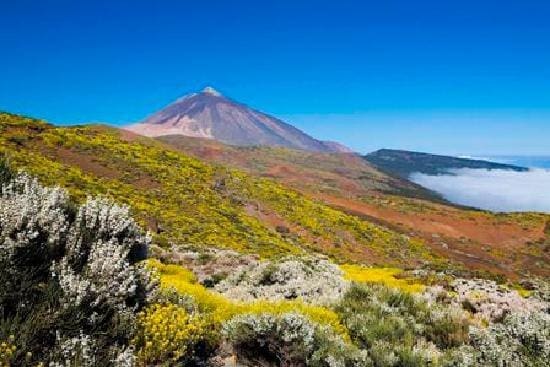
Tenerife was born out of the belly of the Atlantic Ocean, a volcanic eruption that sculpted the land and gave rise to the third largest volcano in the world, El Teide. These violent beginnings make for an arresting landscape. El Teide, with its 17km crater is visible from most parts of the island, a gentle reminder of how the ‘playas’ of the resort centre Santa Cruz de Tenerife gained their dramatic black sand, sizzling into the cooling crystal waters. With all that cooking, little wonder the average temperature is 23º C and it’s known as ‘The Island of Eternal Spring’.
A visit to the Parque Nacional del Teide is a must for any visitor to the island and getting there is easy, no matter where you decide to stay. Hiring a car is probably the best option for exploring the more remote areas of the island and the motorways and roads are all pretty good. (Remember though, a rugged coastline makes for a great scenic drive but it also makes for a few knee-wobbling drops out the driver’s side.) Alternatively, the modern buses that serve the island are frequent, but more importantly, they all have air-conditioning.
Don’t be fooled though. If you do decide to scramble up the face of El Teide, be sure to take something warmer than a pair of swimming shorts. The peak of the mountain is often capped with snow, an odd contradiction to the (long-dormant) fires burning within or even on top of the sands of its near-70 kilometres of charred beaches to the south. The name Tenerife actually means ‘white mountain’ and the desert-like lands that surround it resemble the chalky, pitted surface of the moon – so much so, in fact, that the site was apparently used as a film location for Star Wars. So it was too for The Planet of the Apes and The Ten Commandments. Look out for Los Roques de Garcia, an extraordinary sight, especially if you have come hiking in robe and Charlton Heston-like rambler beard.
The rest of the island is no doubt inordinately photogenic, as a gazillion holiday snaps will testify. Those burning vapours over the seafront of the Playa de las Americas at sunset, the steep looming precipices of Acantilados de Los Gigantes, the rough beauty of Costa Adeje, the hills to the north scattered with thick patches of pine, all slightly muted by the silhouette of the magnificent still heart of the island, El Teide.

Be the first to comment